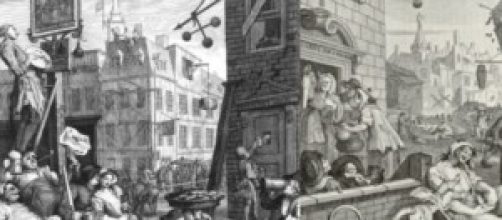On the 250th anniversary of his death, WilliamHogarth remains one of the most fascinating and innovative artists of the 18thcentury. He is most famous for his “modern moral subjects”, a type of Art thatsatirically mirrors the manners and morals of the period in whichhe lived.
Particularly interesting, extravagant, and somehow verycontemporary, is the engraving Gin Lane which is perhaps the best-known pieceof propagandist art ever produced in England. It artfully depicts London’sdescent into the gin craze: the year was 1751, a period when poor people weredrinking to forget misery.
And they were drinking gin, in pint glasses: in the18th century, Londoners were on average drinking two pints per headper week.
People were completely addicted to this liquor: thegovernment’s attempts to stop the flow of gin mainly resulted into riots andcries of “No Gin, No King”. Hogarth, along with his friend novelist Henry Folding,thus thought they should be the ones to highlight the problems relating todrinking gin and to get the message across.
At the centre of this picture of decay, a drunk woman letsher child slip from her arms, presumably to its death. The whole image is aportrait of despair, starvation, beggary, suicide, poverty, and the collapsingbuildings stand as a metaphor for the deterioration of all morals and society.
More than two hundred years later, this witty, provocative,and satirical engraving is very much at home in our contemporary society. Publicworries and moral panic associated with drink are indeed modern phenomena. As Professor PeterBorsay - whose work has being published on the History & Policy website -said: 'At first glance, the parallels between the 18th century gin craze andcontemporary binge drinking appear striking.
I don't think it's the drinkingthat merits the comparison, but the moral panics that characterised bothperiods, fuelled by pressure groups, the mediaand perceptions of government complacency."
Truly, Alcohol and moral panic over binge drinking wereeverywhere - and still are. Yet there is probably a difference between past andpresent.
Going back to Hogarth, we shall not forget Gin Lane’s companion piece,Beer Street. If the former is a strong critique to this evil foreign liquor,this other 1751 Hogarth’s engraving encourages viewers to drink the weaker andlocal ale. People in Beer Street are prosperous, joyful and the message conveyed isthat not only beer is good but also inspiring for artists.
And here lies the difference: nowadays, there is no more distinctionbetween Beer Street and Gin Lane, no distinction between poor and rich, beer and gin: drinking is the problem, and it is universal. If drinking habits mightdiffer among social classes, alcohol is what remains, matters, and scares. Butif we have no misery to forget, what is the reality we are trying to escape?And this perhaps is what should worry the most.

